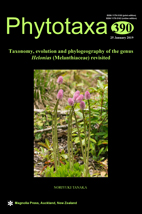Abstract
This paper reviews the taxonomy, evolution and phylogeographic aspects of the genus Helonias L. sensu lato, including Ypsilandra and Heloniopsis (Melanthiaceae) that are basically similar in many morphological and ecological characters to Helonias sensu stricto. It includes three parts, I–III. In Part I, characters and their variation are examined to determine generic traits and diversity. In Part II, an attempt is made to taxonomically determine diversity among individuals. Taxonomic conclusions and revisions are principally the following: Helonias comprises 12 species, which are classified into two sections, H. sect. Helonias and H. sect. Heloniopsis comb. & stat. nov. Helonias sect. Helonias consists of H. bullata only; H. sect. Heloniopsis comprises two subsections, H. subsect. Ypsilandra comb. & stat. nov. and H. subsect. Heloniopsis. Helonias subsect. Ypsilandra is composed of five species previously published under the genus Ypsilandra. Helonias subsect. Heloniopsis consists of two series, H. ser. Umbellatae ser. nov., with three species from Taiwan and the Nansei Islands (incl. the Ryukyus), Japan, and H. ser. Heloniopsis, with three species from Japan, Korea and E. Russia (southern Sakhalin). Helonias yunnanensis var. mesostyla is described as a new variety from N Myanmar and SW China (NW Yunnan). The new combinations Helonias koreana (from Korea) and H. parviflora (from China) are proposed. Lectotypes for Ypsilandra parviflora, Y. thibetica, Y. yunnanensis var. micrantha, Heloniopsis breviscapa and H. grandiflora are designated. A revised typification for Sugerokia japonica is proposed, negating a previous lectotypification. Heloniopsis tubiflora is reduced to synonymy under Helonias koreana. In Part III, the evolutionary and phylogeographic aspects of Helonias are discussed, and a phylogram inferred from cladistic analysis of phenotypic characters is presented. In the phylogram, Helonias is monophyletic, while H. sect. Helonias and H. subsect. Ypsilandra are respectively paraphyletic, and H. subsect. Heloniopsis is monophyletic. Incongruence in results between morphological and DNA sequence analyses is briefly discussed.

